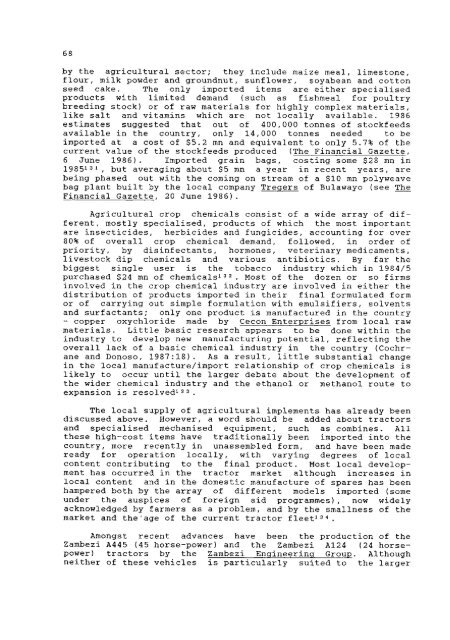Zimbabwe - Overseas Development Institute
Zimbabwe - Overseas Development Institute
Zimbabwe - Overseas Development Institute
You also want an ePaper? Increase the reach of your titles
YUMPU automatically turns print PDFs into web optimized ePapers that Google loves.
y the a g r i c u l t u r a l sector; they include maize meal, limestone,<br />
f l o u r , milk powder and groundnut, sunflower, soyabean and cotton<br />
seed cake. The only imported items are e i t h e r s p e c i a l i s e d<br />
products with l i m i t e d demand (such as fishmeal f o r p o u l t r y<br />
breeding stock) or of raw m a t e r i a l s for h i g h l y complex m a t e r i a l s ,<br />
l i k e s a l t and vitamins which are not l o c a l l y a v a i l a b l e . 1986<br />
estimates suggested that out of 400,000 tonnes of stockfeeds<br />
a v a i l a b l e i n the country, only 14,000 tonnes needed to be<br />
imported at a cost of $5.2 mn and equivalent to only 5.7% of the<br />
current value of the stockfeeds produced (The F i n a n c i a l Gazette,<br />
6 June 1986). Imported g r a i n bags, c o s t i n g some $28 mn i n<br />
1985''!, but averaging about $5 mn a year i n recent years, are<br />
being phased out with the coming on stream of a $10 mn polyweave<br />
bag plant b u i l t by the l o c a l company Treqers of Bulawayo (see The<br />
F i n a n c i a l Gazette, 20 June 1986).<br />
A g r i c u l t u r a l crop chemicals c o n s i s t of a wide array of d i f <br />
ferent, mostly s p e c i a l i s e d , products of which the most important<br />
are i n s e c t i c i d e s , h e r b i c i d e s and f u n g i c i d e s , accounting f o r over<br />
80% of o v e r a l l crop chemical demand, followed, i n order of<br />
p r i o r i t y , by d i s i n f e c t a n t s , hormones, v e t e r i n a r y medicaments,<br />
l i v e s t o c k dip chemicals and various a n t i b i o t i c s . By f a r the<br />
biggest s i n g l e user i s the tobacco i n d u s t r y which i n 1984/5<br />
purchased $24 mn of chemicals''^ . Most of the dozen or so firms<br />
involved i n the crop chemical industry are i n v o l v e d i n e i t h e r the<br />
d i s t r i b u t i o n of products imported i n t h e i r f i n a l formulated form<br />
or of c a r r y i n g out simple formulation with e m u l s i f i e r s , solvents<br />
and s u r f a c t a n t s ; only one product i s manufactured i n the country<br />
- copper oxychloride made by Cecon E n t e r p r i s e s from l o c a l raw<br />
m a t e r i a l s . L i t t l e basic research appears to be done w i t h i n the<br />
i n d u s t r y to develop new manufacturing p o t e n t i a l , r e f l e c t i n g the<br />
o v e r a l l lack of a basic chemical i n d u s t r y i n the country (Cochrane<br />
and Donoso, 1987:18). As a r e s u l t , l i t t l e s u b s t a n t i a l change<br />
i n the l o c a l manufacture/import r e l a t i o n s h i p of crop chemicals i s<br />
l i k e l y to occur u n t i l the l a r g e r debate about the development of<br />
the wider chemical i n d u s t r y and the ethanol or methanol route to<br />
expansion i s r e s o l v e d ' " .<br />
The l o c a l supply of a g r i c u l t u r a l implements has already been<br />
discussed above. However, a word should be added about t r a c t o r s<br />
and s p e c i a l i s e d mechanised equipment, such as combines. A l l<br />
these high-cost items have t r a d i t i o n a l l y been imported i n t o the<br />
country, more r e c e n t l y i n unassembled form, and have been made<br />
ready f o r operation l o c a l l y , with varying degrees of l o c a l<br />
content c o n t r i b u t i n g to the f i n a l product. Most l o c a l development<br />
has occurred i n the t r a c t o r market although increases i n<br />
l o c a l content and i n the domestic manufacture of spares has been<br />
hampered both by the array of d i f f e r e n t models imported (some<br />
under the auspices of f o r e i g n a i d programmes), now widely<br />
acknowledged by farmers as a problem, and by the smallness of the<br />
market and the'age of the current t r a c t o r f l e e t ' ' " .<br />
Amongst recent advances have been the production of the<br />
Zambezi A445 (45 horse-power) and the Zambezi A124 (24 horsepower)<br />
t r a c t o r s by the Zambezi Engineering Group. Although<br />
neither of these v e h i c l e s i s p a r t i c u l a r l y s u i t e d to the l a r g e r
















